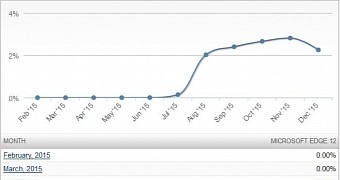Edge is Microsoft's new browser for Windows 10 that's supposed to be a stronger rival for the likes of Google Chrome and Mozilla Firefox, but it seems that at least for now, its adoption is well below expectations.
Figures revealed by market research firm Net Applications for the month of December 2015 reveal that Edge is still losing users, and the lack of features, such as extensions, is very likely to be one of the main reasons.
Last month, Internet Explorer 11 was the number one browser out there with a share of 25.57 percent, and that's not a surprise at all. IE11 is the default browser on up-to-date computers running Windows 7 and 8.1, and since these two are the most used desktop OS versions across the world, Internet Explorer is doing well too.
Chrome 47 is the runner-up in the charts, according to Net Applications, with a share of 15.68 percent, while IE8 and IE9 come next, but far behind, with 8.95 and 6.67 percent, respectively.
Edge performance
As far as Microsoft Edge is concerned, the default Windows 10 browser is currently powering only 2.25 percent of the world's PCs. While its market share is quite low, keep in mind that Edge only exists on Windows 10, and right now, this version barely powers 10 percent of the desktops.
But on the other hand, Edge's performance is not at all the one we expected it to be, as the browser keeps seeing users go and loses ground in the race against its rivals. In November, for instance, Edge was used by 2.81 percent of the desktop PC consumers, so it lost 0.56 percent in just one month.
Edge could recover in the coming months, as Microsoft is working to roll out big feature updates, such as extension support. The Redstone release expected in mid-2016 is the one that could finally make Edge a better rival for Chrome and Firefox.

 14 DAY TRIAL //
14 DAY TRIAL //